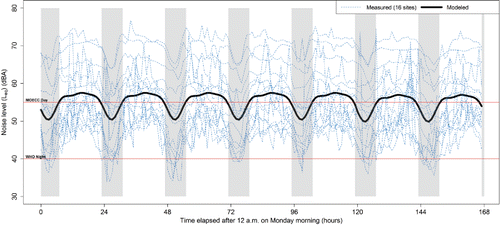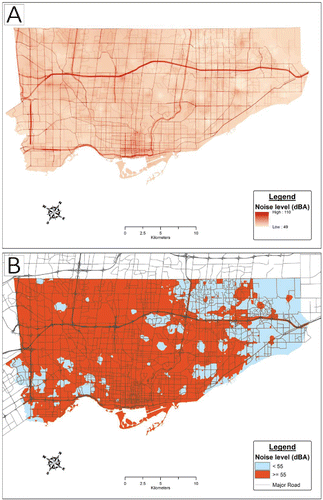Figures & data
Figure 1. Locations in Toronto where noise measurements were collected. Short-term sampling sites for (A) cycle one, (B) cycle two, and (C) cycle three. (D) Long-term (7-day) sampling sites. For long-term sampling sites: Site 1 = Wentworth Avenue; Site 2 = Barbara Crescent; Site 3 = Dufferin Street; Site 4 = Bowood Avenue; Site 5 = Bloor Street; Site 6 = Queens Quay West; Site 7 = Lawton Boulevard (west side); Site 8 = Lawton Boulevard (east side); Site 9 = Chase Road.; Site 10 = Protea Gardens; Site 11 = Genella Square; Site 12 = Singer Court; Site 13 = Gala Lane; Site 14 = Tullis Drive; Site 15 = Lamb Avenue; Site 16 = Parkview Hill Crescent.

Figure 2. Measured and model-estimated temporal noise variation in Toronto during a 7-day week. Shaded regions correspond to nighttime (11 p.m.–7 a.m.). Horizontal lines correspond to the nighttime noise guideline (40 dBA, 8-hr Leq) recommended by the World Health Organization (WHO) for health protection and the daytime road traffic sound guideline (55 dBA, 16-hr Leq) for outdoor living areas recommended by the Ontario Ministry of the Environment and Climate Change (MOECC).

Figure 3. Nighttime (2 a.m.–2:30 a.m.) noise levels in Toronto. Noise levels (A) on a continuous scale and (B) categorized based on a 55-dBA cut-off, as estimated using the final predictive surface.

Table 1. Nighttime and daytime road traffic noise levels reported for North American and western European cities.
